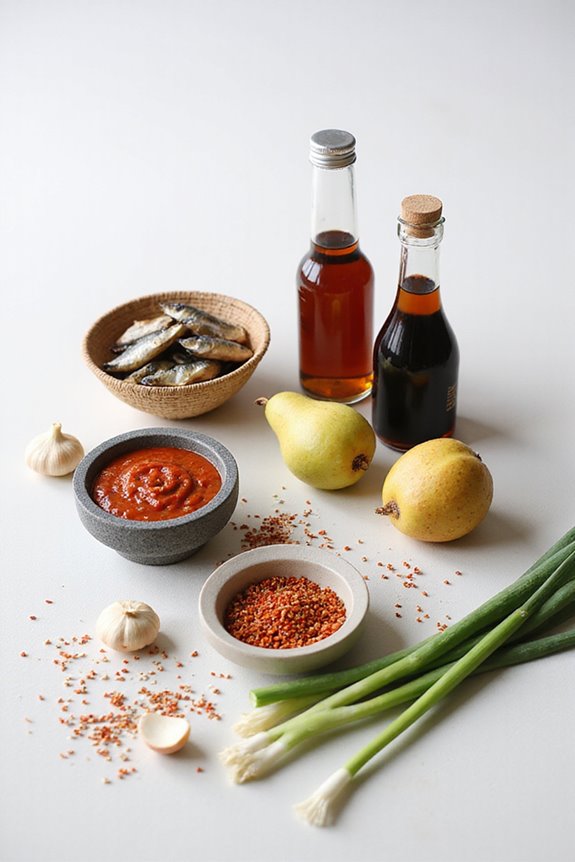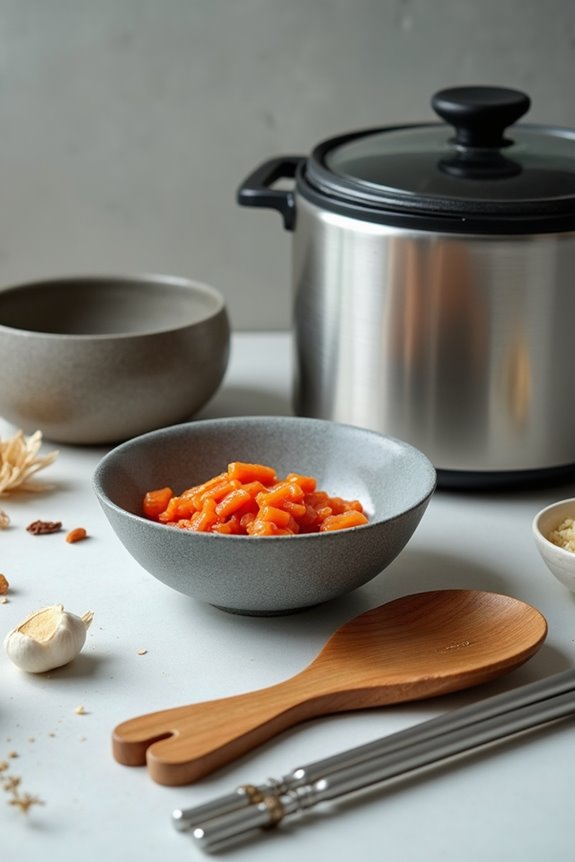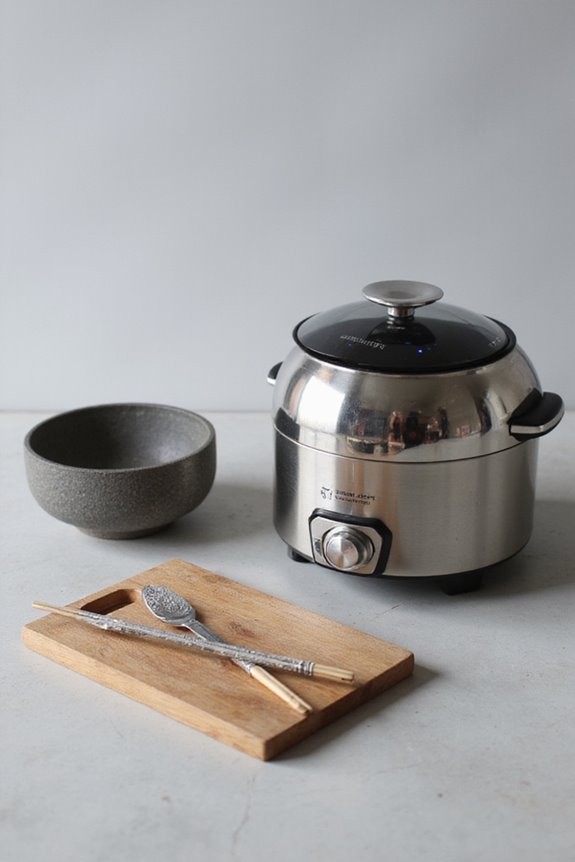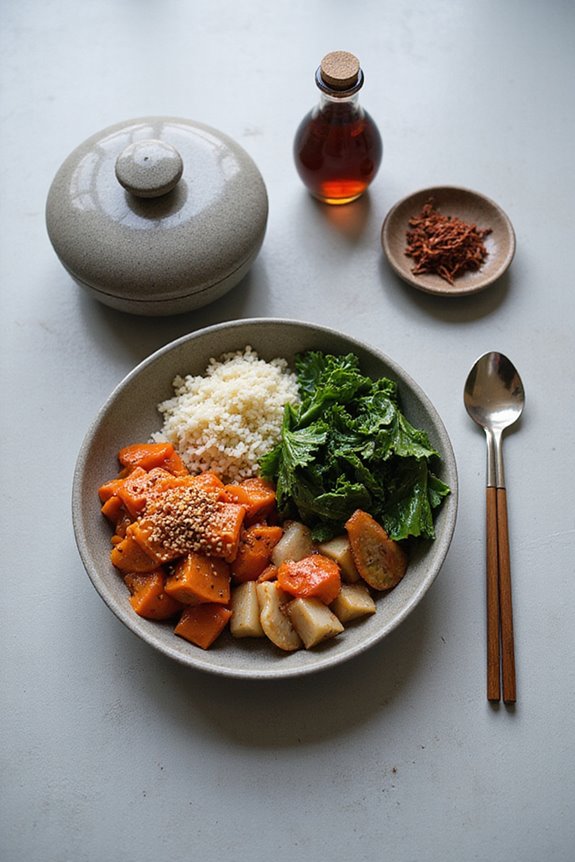Korean cooking secrets lie in our rich culinary traditions that blend unique techniques with fundamental ingredients. We often use marinades, incorporating soy sauce, garlic, and sesame oil, to enhance flavors in dishes like bulgogi. Fermentation plays a critical role, exemplified by kimchi, which enriches taste and preserves food. The balance of rice, side dishes, and soup creates harmony in meals. Understanding these methods and ingredients is essential, and more insights await as we explore deeper aspects of Korean cuisine.
Key Takeaways
- Embrace fermentation; using ingredients like kimchi and doenjang enhances depth and authenticity in flavors while preserving food.
- Master the art of marination with core ingredients like soy sauce, garlic, and ginger for optimal flavor absorption in meats.
- Utilize a variety of textures and temperatures by incorporating multiple banchan and a balanced main dish to create harmonious meals.
- Leverage traditional cooking methods like simmering and grilling to elevate the flavors and nutritional benefits of meals.
- Invest in essential fermented sauces (ganjang, doenjang, gochujang) as foundational components for creating authentic Korean dishes.
Traditional Cooking Methods
Korean cooking methods have a rich heritage that showcases a variety of techniques, which we can explore to better appreciate the cuisine’s depth. We frequently use cooking utensils like stone pots, traditional woks, and clay vessels, which play a crucial role in our food preparation. Boiling and simmering are common techniques for soups and stews, allowing ingredients to meld their flavors. We also employ fermentation to enhance taste and preserve ingredients, as seen in kimchi. Grilling over open flames is popular for meats, while steaming is used for vegetables. Additionally, frying techniques, particularly for quick stir-fries, enable us to prepare flavorful dishes efficiently. Each method reflects our cultural traditions and love for wholesome flavors. The use of fermented ingredients like kimchi not only adds unique flavors but also contributes to gut health and overall nutrition.
Core Ingredients of Korean Cuisine
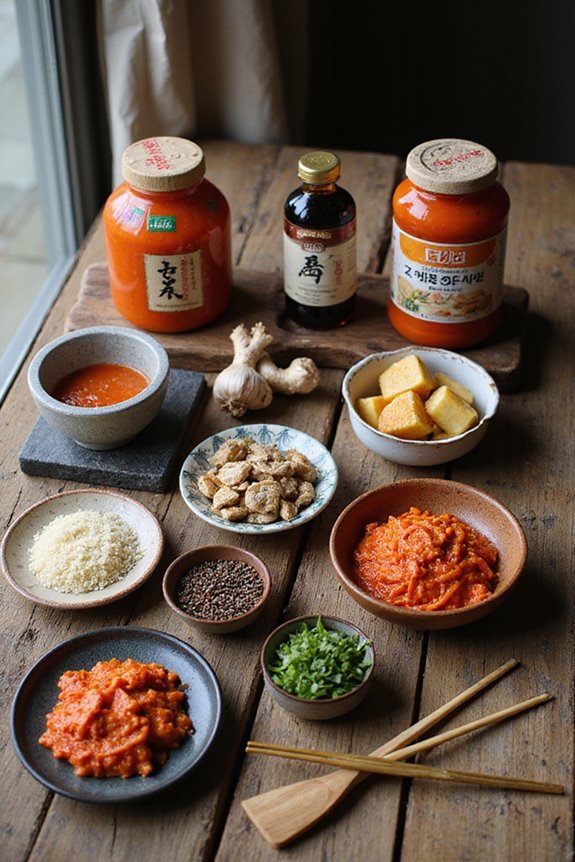
To appreciate the essence of Korean cuisine, we need to focus on its core ingredients, which form the backbone of countless dishes and flavors. Central to this cuisine are essential fermented sauces like ganjang (soy sauce), doenjang (soybean paste), and gochujang (chili paste); these impart core flavors vital for seasoning various dishes. We also rely on essential proteins such as samgyeopsal (Korean pork belly) and seafood components, including dried anchovies and fish cakes, to enhance our meals. Common pantry staples, like sesame oil and garlic, add depth, while dried seaweed and rice contribute texture and nutrition. Together, these ingredients create the distinctive tastes and hearty dishes that define Korean cooking, making it beloved worldwide. Additionally, the use of traditional ingredients like fermented soybeans and red chili pepper is significant for achieving true Korean flavors.
Meal Structure and Dish Types
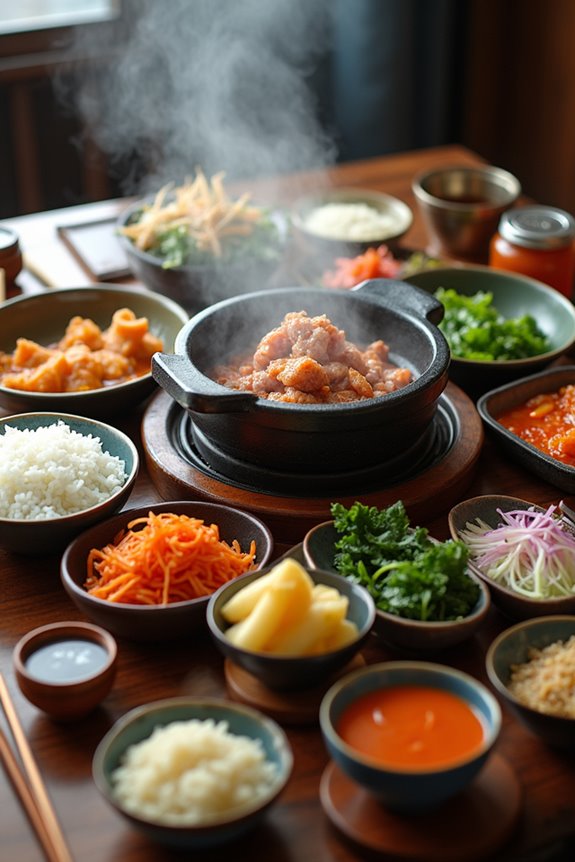
While exploring the intricacies of traditional meal structure, we find that a typical Korean meal emphasizes balance and variety. Central to this structure is a bowl of rice, accompanied by a soup or stew, such as kimchi jjigae. Multiple small side dishes, known as banchan, play a vital role in achieving meal harmony. These dishes often comprise pickled, fermented, or fresh vegetables, with banchan variety ranging from three to over ten types per meal. Each banchan contributes distinct flavors and textures, allowing diners to savor spicy, sour, or crunchy elements. Meals are typically served communally, fostering a shared dining experience that enhances both taste and conversation, reflecting the essence of Korean culinary traditions.
The Art of Marination
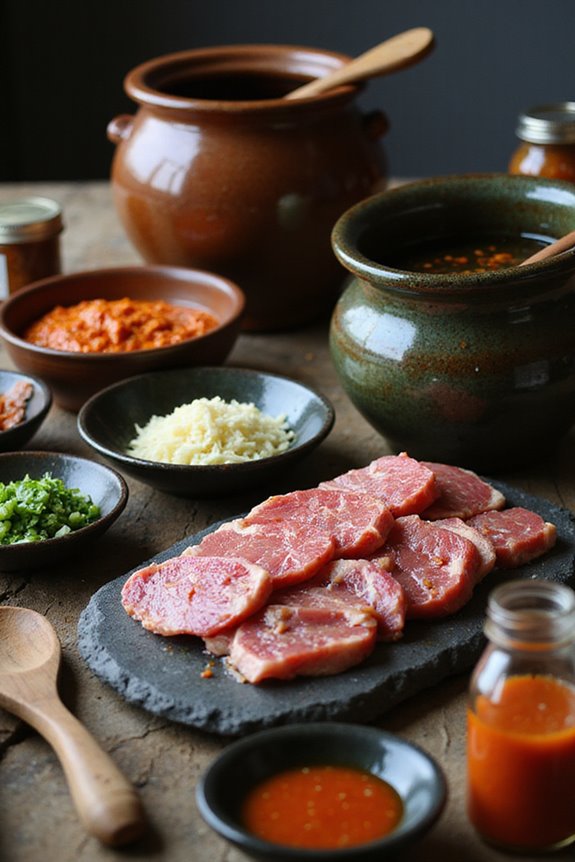
Marination is a key aspect of flavor development in many dishes, enhancing both taste and texture. In Korean cooking, achieving a proper flavor balance is essential. We rely on core ingredients like soy sauce for umami, garlic and ginger for warmth, and sesame oil for richness. Marination timing varies with each protein; for instance, seafood benefits from a quick 15–30 minutes, while meats such as chicken or beef can marinate for up to 4 hours. Gentle massage of the marinade into the meat improves absorption and texture. Using airtight containers also optimizes contact and prevents contamination. Incorporating natural sweeteners like Korean pear not only tenderizes but elevates the overall flavor, making each dish uniquely savory and aromatic. Additionally, using authentic ingredients like gochujang can enhance the depth of flavor in marinades.
Grilling Techniques for Flavor
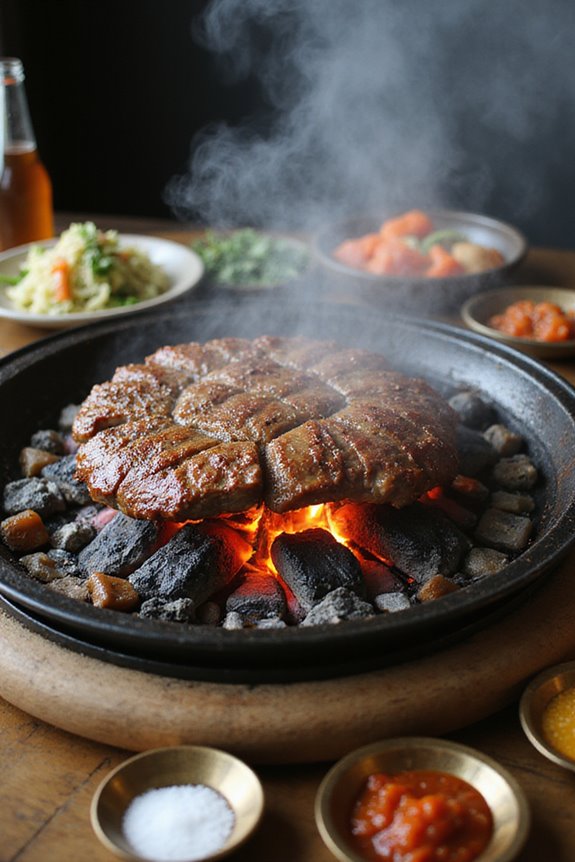
Grilling techniques play an essential role in achieving flavorful Korean dishes, as they help to enhance the natural qualities of the proteins being cooked. First, we should maintain our grills meticulously, guaranteeing a clean surface for peak flavor layering. Starting with fatty meats like pork belly allows us to render oils that season the grill, preparing it for leaner cuts such as bulgogi. We must avoid overcrowding the grill to guarantee even cooking and monitor the heat closely to prevent flare-ups. After grilling marinated meats last, we’ll discover complex flavor integration without excessive caramelization. Finally, incorporating fresh vegetables like garlic and jalapeños alongside the meat enriches the overall taste, offering aromatic depth and texture to our meals.
Importance of Preservation and Fermentation
Understanding the importance of preservation and fermentation in Korean cuisine reveals not only practical benefits but also cultural insights that have shaped culinary practices for generations. Fermentation techniques, like those involving *meju* and *jangdokdae*, promote microbial diversity, enhancing flavors and nutritional benefits. These historical practices extend the usability of seasonal ingredients, allowing families to strategically preserve crops and enjoy diverse meals year-round. The cultural significance of fermented foods, such as *doenjang* and kimchi, is evident in family traditions that pass down recipes through generations. Additionally, properly maintained spaces for fermentation embody a communal spirit, representing harmony with nature while ensuring food security. Overall, fermentation plays an essential role in crafting and sustaining Korean culinary identity and heritage.
Regional and Seasonal Variations
The art of Korean cooking is deeply influenced by regional and seasonal variations that are integral to its culinary landscape. For instance, regional kimchi varies markedly across Korea; in Gyongsang Province, it emphasizes bold flavors through more garlic and chili, while Gangwon Province offers lighter, less spicy versions using fresh vegetables. Seasonal ingredients also play a critical role; spring often highlights wild greens, while summer brings a focus on fresh seafood. As colder months approach, heavier, fermented dishes such as kimchi take center stage. Each province crafts its specialties using local ingredients, reflecting the climate and agriculture, thereby creating a diverse tapestry of flavors that is uniquely Korean. Understanding these aspects elevates our appreciation for its rich culinary traditions.
Enhancing Umami and Balance in Dishes
Enhancing umami and maintaining balance in Korean dishes require a thoughtful approach to ingredients and techniques. We often rely on fermented soybean products like doenjang and ganjang, which serve as foundational umami enhancers in various meals. Additionally, dried anchovies, kelp, and shiitake mushrooms greatly deepen broth flavors, while aged gochujang introduces complex savory notes. For effective umami extraction, slow simmering broths preserves glutamate integrity. Layering umami-rich ingredients, such as tomatoes and onions, during cooking aids in flavor balancing, ensuring no single element overwhelms the dish. Balancing the umami with acidity, using vinegar or citrus, lightens the overall taste, while incorporating mild sweetness can harmonize intense savory notes, creating a well-rounded dining experience.
Frequently Asked Questions
What Utensils Are Essential for Traditional Korean Cooking?
When we’re exploring traditional Korean cooking, essential kitchen tools include long cooking chopsticks, a ttukbaegi for stews, and a rice cooker for perfect rice. These cooking equipment enhance our culinary experience and guarantee great flavors.
How Can I Make Homemade Kimchi as a Beginner?
So, we all think kimchi fermentation’s a magical process, right? Let’s keep it simple: we’ll need basic ingredients like napa cabbage, gochugaru, and fish sauce, and soon, our homemade kimchi will be legendary!
What Are Common Substitutes for Traditional Korean Ingredients?
When exploring Korean ingredient substitutions, we can use alternatives like miso for doenjang or smoked paprika for gochugaru. These choices offer alternative flavor profiles while still allowing us to enjoy delicious Korean-inspired dishes together.
How Do Korean Cooking Methods Promote Health and Nutrition?
Korean cooking methods promote health through fermented foods that enhance gut health. By focusing on balanced meals with lean proteins and vibrant vegetables, we create nutritious dishes that support overall wellness and energy.
What Is the Cultural Significance of Shared Meals in Korea?
Did you know over 60% of Korean meals are shared? These meal rituals and communal dining foster bonds, enhance communication, and embody respect, creating a sense of belonging that’s central to our rich cultural heritage.


